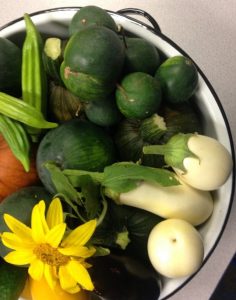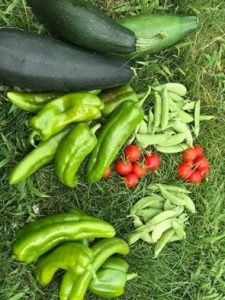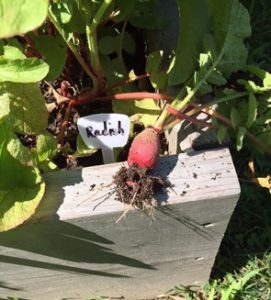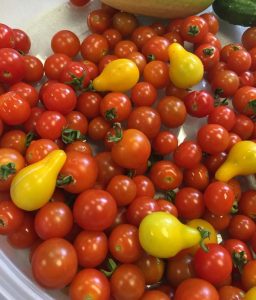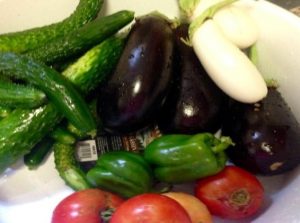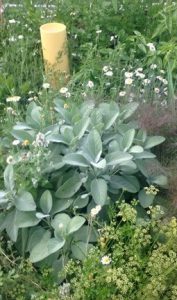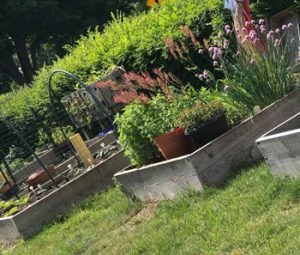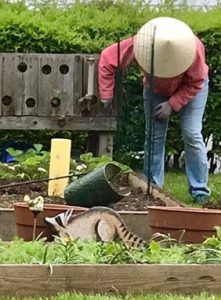Library Community Garden
Our Seed Library debuted in spring 2022 and we are currently accepting seed donations for next year.
We have an informal gardening group meeting at 9:30 am on Tuesdays once the weather is over 50 degrees through the first frost.
GRAFTON PUBLIC LIBRARY’S GARDENS AND GROUNDS
by Beth Patch
I began the raised vegetable beds at the Grafton Public Library the spring of 2015 after hearing many times that people were interested in having a seed library. Four beds were built the first year with a lot of effort going into creating great soil in each of the beds.
 Loom was ordered from Perrault Nurseries and bags of composted manure, lime and cubes of peat moss were purchased and hauled to the Library site from Koopmans. A Boy Scout troop helped out the first year by hauling wheelbarrows full of loom to the beds and then spreading the amenities into each bed. Digging everything in we let the soil sit for a couple weeks in the rain and made our first plantings that spring. I thought I would be planting by myself; however, just as I was about to pat down the first row of seeds a carload of Girl Scouts arrived and we planted the first beds together.
Loom was ordered from Perrault Nurseries and bags of composted manure, lime and cubes of peat moss were purchased and hauled to the Library site from Koopmans. A Boy Scout troop helped out the first year by hauling wheelbarrows full of loom to the beds and then spreading the amenities into each bed. Digging everything in we let the soil sit for a couple weeks in the rain and made our first plantings that spring. I thought I would be planting by myself; however, just as I was about to pat down the first row of seeds a carload of Girl Scouts arrived and we planted the first beds together.
 Gardening in the raised beds has become a community event with Girl & Boy Scout troops helping to plant in the spring and/or putting the beds to rest for the winter. Two Girl Scouts have worked on their Gold and Silver Awards using the raised beds as the background for their projects. An additional bed was built as a bee garden for one scout working on her Gold Award. She and I built the bed, hauled the soil and amenities, and planted herbs and flowers to attract bees with other children. The Girl Scout used the planting time as an educational part of the process. The following summer when the bee bed was in bloom, we planned an interactive event on a Saturday afternoon for children to learn about plants that attract bees and the life of bees.
Gardening in the raised beds has become a community event with Girl & Boy Scout troops helping to plant in the spring and/or putting the beds to rest for the winter. Two Girl Scouts have worked on their Gold and Silver Awards using the raised beds as the background for their projects. An additional bed was built as a bee garden for one scout working on her Gold Award. She and I built the bed, hauled the soil and amenities, and planted herbs and flowers to attract bees with other children. The Girl Scout used the planting time as an educational part of the process. The following summer when the bee bed was in bloom, we planned an interactive event on a Saturday afternoon for children to learn about plants that attract bees and the life of bees.
 We now have seven raised beds. Over time we have planted corn, tomatoes, green peppers, and a variety of cucumbers, snap peas, green beans, okra, sugar baby watermelons, sugar pumpkins, and a variety of herbs both in a raised bed and in pots. We have harvested beautiful eggplant, zucchini, and yellow squash.
We now have seven raised beds. Over time we have planted corn, tomatoes, green peppers, and a variety of cucumbers, snap peas, green beans, okra, sugar baby watermelons, sugar pumpkins, and a variety of herbs both in a raised bed and in pots. We have harvested beautiful eggplant, zucchini, and yellow squash.
I have built arches out of fencing and PVC pipe to support our vining plants. Even with arches, we do have problems with stray vines crawling out of the beds, causing our local Department of Public Works (DPW) to cut them down even when there is large fruit in evidence.
As well, I built a strawberry bed out of pallets. The strawberry plants are gradually taking hold – we have gained sweet tasting strawberries from this standing bed. We did have wooden barrels of blueberries which lie in broken barrels due to being attacked by the lawnmower.
Large PVC tubes were used to create worm tubes and placed in the center of each bed so that worms can be composted at the tubes center and encouraged to crawl in and out of the buried portion of the tube where countless holes were drilled. Our Teen Librarian painted garden designs on each of the tubes. Worms were farmed at the Library and interested children participated in the farming of the worms.
The raised beds, formal beds and outside potted plants are always conversations starters and a lot of interest is expressed while I am outside working. We receive numerous compliments on all of the work that has been completed on the Library grounds. I will say that between spring planting and fall garden cleanup, it can be difficult to get anyone to assist with weeding and watering the beds (raised or formal). I often come daily to ensure that our various plantings receive the water they need to survive and are not choked with weeds. Getting individuals to help out consistently is a real problem.
Working outside in the gardens is a great public relations tool and a wonderful way to get to know each other. As well, the community loves all the improvements that have been done to the property. At some point, I realized I could not do everything by myself and invested a portion of the garden’s budget in hiring Linda Casey, another avid garden lover with skills to help me. This summer we were fortunate to have a volunteer, Jacob Ricker, from the University of Connecticut as well.
In the formal beds we have old and new plantings. Many of the old plants had been ignored for a long time and with care and maintenance have begun to come back and thrive. We have two grand hydrangea shrubs and two magnificent oak-leaved hydrangea shrubs, a lovely yellow rhododendron, and several azaleas – the yellow rhododendron requires tender loving care as it had been ignored for a long time. There is an impressive mountain laurel which suffered a tremendous amount of damage during a spring storm in 2018. There are two dogwood trees on the property, each having their own special needs. The dogwood at the front entrance was damaged in the same spring storm as the mountain laurel. Of note, those previously noted, shrubs in our formal beds include: Stewartia, Elderberry, Ninebark, Holly, Euonymus, Rose of Sharon, Butterfly bush, and Weigela.
Library staff created their own paving stones, which were placed in a formal bed. A fairy garden created by Linda Casey, employed for a year as a Garden Assistant, was placed at the end of the paving stone path. This was a fun project which included all Library staff.
We have various varieties of hosta, iris, and phlox, black-eyed Susan’s, sedums, zinnia, etc. Our raised beds are never without sunflowers which are a favorite of patrons and those driving past the Library. I often hear about the sunflowers on the grounds of the Grafton Public Library in the most unexpected places. We have an herb bed and pots of herbs. In the children’s bed, small vegetables are planted: peas, beans, tomatoes, cucumbers, sugar pumpkins, baby watermelons and herbs which smell yummy at the brush of a small hand. Of course, we plant small varieties of sunflowers in the children’s bed as well.
The Library’s property is communal. We’ve had family picnics on the lawn during events on the Common and even with the Library closed for renovation in summer 2019, people came to sit on the steps of the Library or on blankets in the grass until construction fencing went up in fall 2019. Patrons walk through the raised beds, commenting on what is growing. During Halloween, spooky creatures are set up on the front lawn; the community comes to have their pictures taken in front of the ghouls and the creatures have become a part of the local communities Halloween night celebration. With all the work that has been completed in the last few years, our grounds have become a place to be, a destination, an attraction, and have received positive feedback.
Working in the formal beds of the Grafton Public Library, creating the raised bed gardens, placing holiday themed decorations on the grounds of the library are an essential part of me. Whether working in the raised beds or erecting holiday creatures with my grandchildren; working with scouts or discussing gardening with patrons and passersby, I love that my contribution to the library, library patrons, and to the Grafton community is gardening.
I thank everyone that has joined in the beautification and education of the Library and to it’s patrons. They are fabulous, generous individuals who hauled soil and amenities, planted, harvested, cleaned, and sometimes watered. Thanks to each of you.
I look forward to replanting the raised beds and getting to know the people who also love gardens and will join me to build future beds. I will be exciting to see up close the formal beds and what their condition will be after 18 months or more. We have a lot to look forward to!
For photos of the library gardens, please visit our photo album online at https://www.facebook.com/media/set/?set=a.3972243876165375&type=3

